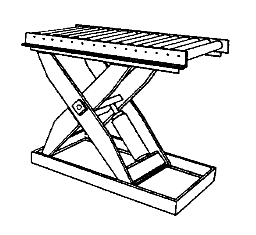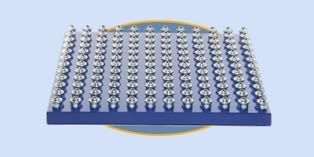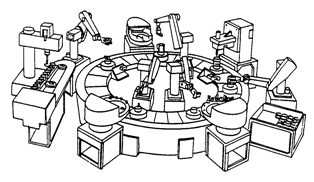Positioning equipment is used to handle material at a single location so that the material is in the correct position for subsequent handling, machining, transport, or storage. Unlike transport equipment, positioning equipment is usually used for handling at a single workplace. Material can also be positioned manually using no equipment.
As compared to manual handling, the use of positioning equipment can provide the following benefits [Modern Materials Handling, Sept. 1993]:
- raise the productivity of each worker when the frequency of handling is high,
- improve product quality and limit damage to materials and equipment when the item handled is heavy or awkward to hold and damage is likely through human error or inattention, and
- reduce fatigue and injuries when the environment is hazardous or inaccessible.
- Reduce or limit a worker’s lifting and/or reaching motions
- Positioning which involves lifting, tilting or turning load.
Pallet load levelers are also considered as lift and turn tables. Below shows the benefits of a pallet load levelers.
- Used in manual palletizing to reduce the amount of bending and stooping involved with manually loading a pallet by combining a lifting and turning mechanism with a device that lowers the table as each layer is completed so that loading always takes place at the optimal height of 30 inches
- Used in conveyor systems to permit manual transfer to and from machines and conveyors and between different sections of conveyors.
- Ball friction limits the maximum load weight to 600 lbs as loads are pushed on the table.
- The ball transfer table is ideal for products which must be rotated or positioned from one work station to another.
- Steel balls are friction-free and easily glide boxes, packages, etc. in any direction.
- Can be floor mounted or placed on adjustable H-stands for work-height jobs.
- Three separate ball styles available. Custom sizes optional: stainless steel tables, stainless or nylon ball, etc.
- For the synchronous transfer of small parts from station to station in a single work center.
- Circular table rotates in discrete intermittent steps to advance parts between stations located along its perimeter.
- Difficult to put buffers between stations.
Different from conveyors used as in-line indexing machines, where linear transfers can take place between multiple workcenters separated by long distances, since a rotary index table is restricted to circular transfers with a single compact work center.
- Machines that orient parts so that robots or other automated processes can capture and use or package the parts or components.
- Applications range from packaging pills in the pharmaceutical industry to spark plug production in the automotive industry.
- The main difference between parts feeders is their method of directing the feed.
Vibratory bowl feeders are the most common type of parts feeders.
- The bowl has a helical track which climbs the inside wall of the bowl.
- Parts are dumped into the bowl that vibrates and turns.
- As the parts climb the track they encounter obstacles that orient the parts in a certain way. So that they can be easily used further down the line.
Centrifugal rotary feeders use a bowl that spins and forces parts to the outside of the bowl.
- At the outside edge of the bowl, the parts are channeled into receivers when the parts are in the right orientation. From the receiver, they go onto a track that moves the parts to the next stage of production. Centrifugal feeders are usually faster and less noisy than vibratory feeders. They also tend to mar parts less than other types of feeders.
Pneumatic feeders move and position parts by means of a pneumatic piston.
- The piston functions via hydraulic (liquid) pressure or an air-driven motor to force parts through a tube. These units are ideally suited to convey closures to capping machines, but are also applicable for handling many other small parts including liners, fitments, corks, capsules, etc.
Bowls of parts feeders
- Are commonly available in two configurations, although custom bowl types are manufactured.
- Cascade bowls, also known as inside track bowls, are primarily used for feeding easily oriented parts like screws and dowels. They are often quieter and less costly than outside-track designs.
- Outside-track bowls are used when more intricate tooling is required for proper part orientation, for higher feed rates, or for multiple lines of feed. The outside track is pitched downward to improve the separation and orientation of the parts.
Programmable parts feeders are also available.
- They are more flexible than traditional parts feeders and may be programmed to change the way they isolate or orient parts.
- Are available in several different configurations ranging from programmable frequency of vibration in a traditional type of feeder, to sensor driven actuators that reorient parts.
- Robotic parts feeders that use sensors and manipulators to orient parts are also manufactured.
5. Manipulator
Information:
- For vertical and horizontal translation and rotation of loads.
- Act as a "muscle multipliers," manipulators counterbalance the weight of a load so that an operator lifts a small portion (1%) of the load’s weight.
- Can be powered manually, electrically, or pneumatically.
- The end-effector can be equipped with mechanical grippers, vacuum grippers, electromechanical grippers, or other tooling.
- Manipulators fill the gap between hoists and industrial robots: they can be used for a wider range of positioning tasks than hoists and are more flexible than industrial robots due to their use of manual control.
Distinguished from an industrial robot by the use of an operator for control as opposed to automatic computer control.
Articulated Jib Crane Manipulator
Extends a jib crane’s reaching capability in a work area through the use of additional links or "arms".
- Provides increased flexibility because rigid links are not used (vacuum, rigid-link, and articulated jib crane manipulators can all use vacuum gripper end-effectors).
- manipulator designed to move materials, parts and tools, and perform a variety of programmed tasks in manufacturing and production settings.
- Good fit for many applications.
- Often used for arc welding, material handling, and assembly applications.
- Grouped according to number of axes, structure type, size of work envelope, payload capability, and speed.
- A robot controller provides the interface for programming and operating the industrial robot.
- A device called a teach pendant is used to plot the motions needed to perform the application.







